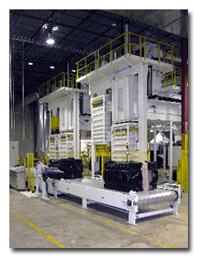For CEO Dr. Uwe Krüger, 2007 was the most successful year in the
Oerlikon Group’s recent history. In total, Oerlikon not only improved its growth curve in
2007, but accelerated it considerably with an organic sales growth rate of more than 20 percent pro
forma to 5.6 billion Swiss francs. Sales values thus exceeded the forecast by up to 5.5 billion
Swiss francs. The operative profit (EBIT) of the continuing business activities of 496 million
Swiss francs increased by 15 percent pro forma compared to 2006.
The net profit reached 319 million Swiss francs. The operative cash flow increased by 42
percent pro forma from 479 million Swiss francs to 678 million Swiss francs. Equity rose by 25
percent from 1.5 billion Swiss francs to 1.9 billion Swiss francs, to reach 30 percent of total
assets. Moreover, the key figure Return on Net Assets improved from 10 percent to 15 percent.
Record Result For Oerlikon Textile
According to Georg Stumpf, chairman of the board, the takeover of Saurer really proved
successful in 2007. In a segment comparison, Oerlikon Textile achieved the best result in its
history with a record increase in sales to 2,719 million Swiss francs – pro forma +27 percent.
According to Oerlikon, the main reason for this increase was the boom in staple yarns in Asian
markets plus the high degree of innovative strength of the segment.
Countless measures to optimize costs and increase productivity have led to an
increase in Oerlikon Textile’s EBIT, which more than tripled to reach 208 million Swiss francs, an
increase of 206 percent pro forma. The EBIT margin increased considerably from 3 percent pro forma
to 8 percent.
Excellent Division Results
Oerlikon Coating also achieved excellent results in 2007, doubling the sales in solar
business. Oerlikon Balzers continued its regional expansion and has meanwhile achieved a global
network of 82 coating centers. Oerlikon Solar increased its sales to more than 300 million Swiss
francs; its orders received increased in 2007 to more than 650 million Swiss francs. The Oerlikon
Vacuum segment exceeded general market growth and achieved sales of 458 million Swiss francs, a
growth of 6 percent. Oerlikon Drive Systems continued its sharp growth rate with a sales increase
of 17 percent pro forma to 1.1 billion Swiss francs. Oerlikon Components developed satisfactorily
in the second half of 2007, with sales growth of 2.3 percent to 344 million Swiss francs.
Innovative Ability Further Improved
A major success factor is the high degree of innovative ability of the Oerlikon
Group, which was further strengthened in 2007. Oerlikon says it enjoys a leading technology role in
all segments, for example with coating technologies or integrated textile machines for the
manufacture of nonwovens.
Research and development costs amounted to 274 million Swiss francs in 2007 compared to 260
million in 2006, and corresponding to a sales quota of 4.9 percent. Approximately 1,500 scientists
and engineers work at Oerlikon on the products of tomorrow; the number of patent-families increased
by 25 percent in 2007 alone.
Asia As The Most Important Growth Market
The Asian market, which is already in the short term set to become the most important and
fastest-growing market, is not only of major importance in the solar business. The Far East –
in particular, China – was region-wise the most important growth market in 2007. Asia’s sales
share in 2007 reached 37.5 percent. Besides Textile, the Coating, Vacuum and Drive Systems segments
all enjoyed double-digit growth rates. Further investments, such as the expansion of the
state-of-the-art factory in Suzhou, China, and the establishment of a second production location in
Singapore are considered. Business in Europe also developed well.
Promising Future
To further increase the earning power, a comprehensive program was implemented at the end of
2007 to optimize costs at Oerlikon’s headquarters, and this is expected to have a significant
savings impact for the current year. OC Oerlikon will continue in 2008 to adhere consistently to
its chosen direction. “Despite unmistakable signs of an economic slowdown, prospects for Oerlikon
remain positive,” Krüger said. The group is active in structural growth areas that will permit a
solid increase in sales and earnings for the medium- and long-term. In 2008, sales should reach
more than 6 billion Swiss francs, and a further increase in earnings is expected. In 2009 at the
latest, the group profit margin should reach more than 10 percent.
April 1, 2008






